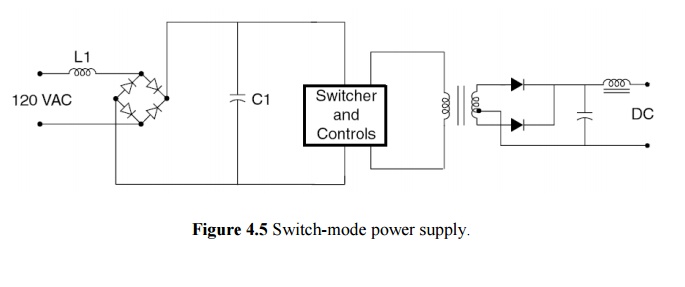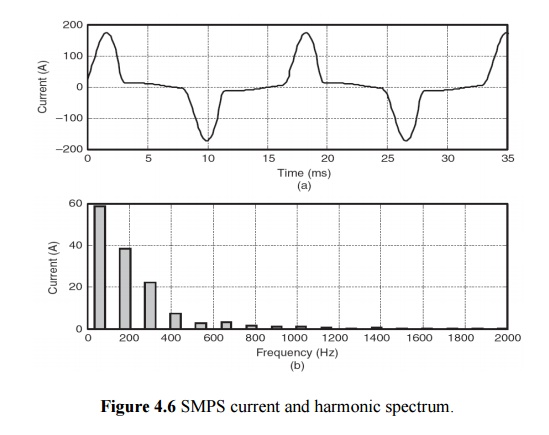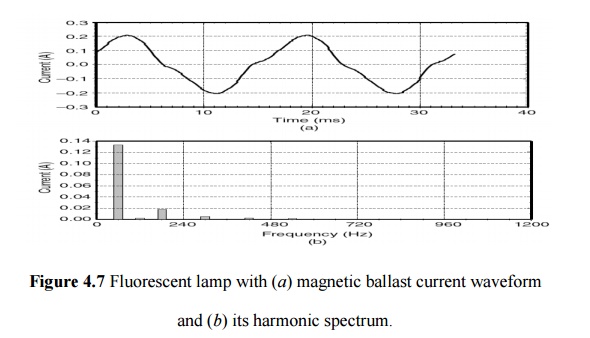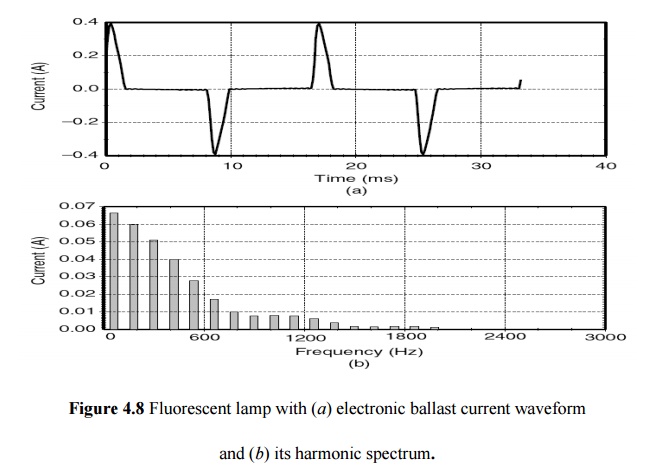Chapter: Power Quality : Harmonics
Harmonic Sources from Commercial Loads
Harmonic Sources from Commercial
Loads
Commercial
facilities such as office complexes, department stores, hospitals, and Internet
data centers are dominated with high-efficiency fluorescent lighting with
electronic ballasts, adjustable-speed drives for the heating, ventilation, and
air conditioning (HVAC) loads, elevator drives, and sensitive electronic
equipment supplied by single-phase switch-mode power supplies. Commercial loads
are characterized by a large number of small harmonic-producing loads.
Depending on the diversity of the different load types, these small harmonic
currents may add in phase or cancel each other. The voltage distortion levels
depend on both the circuit impedances and the overall harmonic current
distortion. Since power factor correction capacitors are not typically used in
commercial facilities, the circuit impedance is dominated by the service
entrance transformers and conductor impedances. Therefore, the voltage
distortion can be estimated simply by multiplying the current by the impedance
adjusted for frequency. Characteristics of typical nonlinear commercial loads
are detailed in the following sections.
1. Single-phase power supplies
Electronic
power converter loads with their capacity for producing harmonic currents now
constitute the most important class of nonlinear loads in the power system.
Advances in semiconductor device technology have fueled a revolution in power
electronics over the past decade, and there is every indication that this trend
will continue. Equipment includes adjustable-speed motor drives, electronic
power supplies, dc motor drives, battery chargers, electronic ballasts, and
many other rectifier and inverter applications.
A major
concern in commercial buildings is that power supplies for single-phase
electronic equipment will produce too much harmonic current for the wiring. DC
power for modern electronic and microprocessor- based office equipment is
commonly derived from single-phase full-wave diode bridge rectifiers. The
percentage of load that contains electronic power supplies is increasing at a
dramatic pace, with the increased utilization of personal computers in every
commercial sector.
There are
two common types of single-phase power supplies. Older technologies use ac-side
voltage control methods, such as transformers, to reduce voltages to the level
required for the dc bus. The inductance of the transformer provides a
beneficial side effect by smoothing the
input
current waveform, reducing harmonic content. Newer-technology switch-mode
supplies (see Fig. 4.5) use dc-to-dc conversion techniques to achieve a smooth
dc output with small, lightweight components. The input diode bridge is
directly connected to the ac line, eliminating the transformer. This results in
a coarsely regulated dc voltage on the capacitor. This direct current is then
converted back to alternating current at a very high frequency by the switcher
and subsequently rectified again. Personal computers, printers, copiers, and
most other single-phase electronic equipment now almost universally employ
switch-mode power supplies. The key advantages are the light weight, compact
size, efficient operation, and lack of need for a transformer. Switch-mode
power supplies can usually tolerate large variations in input voltage.
Because
there is no large ac-side inductance, the input current to the power supply
comes in very short pulses as the capacitor C1
regains its charge on each half cycle. Figure 4.6 illustrates the current
waveform and spectrum for an entire circuit supplying a variety of electronic
equipment with switch-mode power supplies.
A
distinctive characteristic of switch-mode power supplies is a very high
third-harmonic content in the current. Since third-harmonic current components
are additive in the neutral of a three-phase system, the increasing application
of switch-mode power supplies causes concern for
overloading
of neutral conductors, especially in older buildings where an undersized
neutral may have been installed. There is also a concern for transformer
overheating due to a combination of harmonic content of the current, stray
flux, and high neutral currents.


2. Fluorescent lighting
Lighting
typically accounts for 40 to 60 percent of a commercial building load.
According to the 1995 Commercial Buildings Energy Consumption study conducted
by the U.S. Energy Information Administration, fluorescent lighting was used on
77 percent of commercial floor spaces, while only 14 percent of the spaces used
incandescent lighting.1 Fluorescent lights are a popular choice for energy
savings.
Fluorescent
lights are discharge lamps; thus they require a ballast to provide a high
initial voltage to initiate the discharge for the electric current to flow
between two electrodes in the fluorescent tube. Once the discharge is
established, the voltage decreases as the arc current increases. It is
essentially a short circuit between the two electrodes, and the ballast has to
quickly reduce the current to a level to maintain the specified lumen output.
Thus, a ballast is also a current-limiting device in lighting applications.
There are
two types of ballasts, magnetic and electronic. A standard magnetic ballast is
simply made up of an iron-core transformer with a capacitor encased in an
insulating material. A single magnetic ballast can drive one or two fluorescent
lamps, and it perates at the line fundamental frequency, i.e., 50 or 60 Hz. The
iron-core magnetic ballast contributes additional heat losses, which makes it
inefficient compared to an electronic ballast.
An
electronic ballast employs a switch-mode–type power supply to convert the
incoming fundamental frequency voltage to a much higher frequency voltage
typically in the range of 25 to 40 kHz. This high frequency has two advantages.
First, a small inductor is sufficient to limit the arc current. Second, the
high frequency eliminates or greatly reduces the 100- or 120-Hz flicker
associated with an iron-core magnetic ballast.
Standard
magnetic ballasts are usually rather benign sources of additional harmonics
themselves since the main harmonic distortion comes from the behavior of the
arc. Figure 4.7 shows a measured fluorescent lamp current and harmonic
spectrum. The current THD is a moderate 15 percent. As a comparison, electronic
ballasts, which employ switch-mode power supplies, can produce double or triple
the standard magnetic ballast harmonic output. Figure 4.8 shows a fluorescent
lamp with an electronic ballast that has a current THD of 144.
Other
electronic ballasts have been specifically designed to minimize harmonics and
may actually produce less harmonic distortion than the normal magnetic
ballast-lamp combination. Electronic ballasts typically produce current THDs in
the range of between 10 and 32 percent.
A current
THD greater than 32 percent is considered excessive according to ANSI
C82.11-1993, High-Frequency Fluorescent
Lamp Ballasts. Most electronic ballasts are equipped with passive filtering
to reduce the input current harmonic distortion to less than 20 percent.

Since
fluorescent lamps are a significant source of harmonics in commercial
buildings, they are usually distributed among the phases in a nearly balanced
manner. With a delta-connected supply transformer, this reduces the amount of
triplen harmonic currents flowing onto the power supply system.

3. Adjustable-speed drives for
HVAC and elevators
Common
applications of adjustable-speed drives (ASDs) in commercial loads can be found
in elevator motors and in pumps and fans in HVAC systems. An ASD consists of an
electronic power converter that converts ac voltage and frequency into variable
voltage and frequency. The variable voltage and frequency allows the ASD to
control motor speed to match the application requirement such as slowing a pump
or fan. ASDs also find many applications in industrial loads.
Related Topics